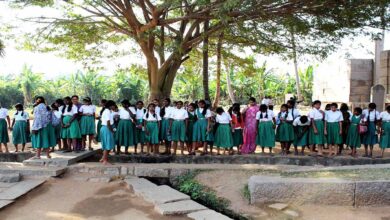The Tea Garden Labourers of Assam
(Their Significant Contributions Versus their stark underdevelopment) - Stephen Ekka
Introduction
The tea garden labourers (the Adivasis) have lived in the Northeast for more than one and half century. Today they form about 20% of Assam’s population and have been the backbone of Tea industry in the state. Their presence is most of the time associated with the tea industry. However, some historians hold it that the Adivasis were present in the NE much before this period. Historians such as Col. Dalton, (in his “Tribal History of India” pg. 235), Edward Gate (in “History of Assam” pg. 4), Hamlet Brach (in “History & Culture of Khasis”) etc. have shown that Adivasis especially the Mundas and Santhal were living together with the Khasis in Meghalaya and as such there is much similarity in the language, some customs, dance, musical instruments etc. Today the community is integral part of Assam. However, due to their existence in a peculiar condition within the tea set up and due to adverse socio economic and educational condition the community lags behind in development.
Contribution of the Tea Garden Labourers
- Contribution to the Huge Profits of Tea Companies:
The tea garden labourers of Assam /(Adivasis) have been playing an indispensible role in the birth, growth and expansion the tea industry. Each tea company makes huge profit on the sweat and blood of these labourers. Based at Guwahati, Assam has the world’s largest CTC auction centre, where around 140 million kg of tea is auctioned annually. Assam produces nearly 400 millions kg or 53 percent of the all-India production. The total estimated turnover of the industry is Rs. 2,000 crore and the industry’s contribution to the state exchequer is Rs. 140 crore.[1]
1.2. Contribution to Assam and Northeast.
The contribution of the tea garden labourers will be better appreciated when their indirect contribution to other subsidiary industries and other sectors are taken into consideration. The tea industry is the oldest industry of northeast India and has been a potential factor in promoting the economy of North-East India. It still provides a stable economic base and has considerable potential for further economic development. The tea plantation industry is a major contributor to the national income as the second biggest foreign exchange earner.[2] Many subsidiary industries like road construction, transportation, building of ware-houses, manufacture of plywood tea chest, aluminium foil, tinplate, metal fittings, paper card board, fertilizers, insecticides, pesticides, coal, iron, steel depend on the tea industry. There is a growing demand for more of these items in the tea industry.[3] Tea industry has been responsible directly or indirectly for clearing of jungle infested lands, for the growth of schools, hospitals, wholesome drinking water etc.[4] The Tea Industry has been mainly responsible for the Assam Trunk Road linking lower Assam and upper Assam, and the steamer service between Bengal and Assam connecting Calcutta to Dibrugarh. The domestic demand for tea continues to rise.[5] Sib Ranjan Misra, an economist, argues that this huge rising domestic consumption will continue to be the main support to prices, particularly when the international market behaves indifferently, will act as a stabilizer in case of need.[6] Besides, the labourers have been contributing to the state, the region and the tea industry by providing political stability and industrial peace.
- The Economic Status of the Labourers
2.1. Income: Income of the labourers is very low and hence their standard of living is low.[7] The wage of a tea garden worker is not only substantially lower than that of a worker in the jute or textile industries, but even much lower than a worker of an unorganized labour such as in coal mines.[8] Their working and living conditions are unhygienic with very meager facilities for medical care.[9] There is maximum exploitation of the women labour and child labour with much less wages.[10]
2.2. Employment and Education: Since tea industry primarily functions on subsistence economy (pays just for the survival of the labourers) hence both parents and children are compelled to work in the tea garden works.[11] Unemployment among them is gradually increasing.[12] Casualization of labourers (reducing the number of permanent workers and increase the temporary ones) is on the rise. On the other hand, the number of permanent workers has been declining progressively. Between the year 1960 and 1980 the permanent workforce has come down by 21, 000 while there has been steady increase in the number of tea gardens, area cultivated and the production of tea.[13] The educational status of the labourers is one of the poorest and the majority of the literates are of LP standard and education of females is rare.[14]
2.3. Land-holding and Debt: The vast majority of the labourers are landless. A small percentage of them have lands outside the tea gardens mostly for cultivation. Under tremendous pressure from the outrageous land grabbers, among whom include tea companies, small tea growers, wealthy land owners, the Adivasi losing lands at an alarming rate. According to a study the income of the tea garden labourers being insufficient about 75% of the tea garden labourers incur debts of different amount.[15]
- Who is responsible for their stark underdevelopment
3.1. Government’s Initiatives for Welfare of Tea Labour
There are three types of institutions which oversee the welfare of labourers: a) The Directorate for Welfare of Tea Garden Tribes (including ex-Tea Garden people), b) the Tea Board and c) the Assam Tea Labour Welfare Board.
3.1.1. The Directorate for Welfare of Tea and Ex-Tea Garden Tribes
The government of Assam established the Directorate for Welfare of Tea Garden and Ex-Tea Garden Tribes in the year, 1983 for the welfare of the labourers. The Directorate has been implementing various Schemes in the State which include – Family Oriented Income Generating Scheme, Pre-Matric and Post-Matric Scholarship, Grants for Non-Government Educational Institutions, Grants for Cultural Activities including Educational Tour, Grants for Non-Government Organisation, Grants to Patients suffering from T. B. and other Malignant diseases, Grants for Purchase of Text-Book and Uniform. The directorate received 50% of the fund from central budget and the remaining 50% from the state government plan allocation.
A quick glace into the amounts of a few of these schemes clearly indicate the government’s negligence and apathy towards the tea garden labourers. For example, under the Family Oriented Income Generating Scheme (FOIGS) the amount allotted for tea garden labour community (who compose 25% of the population of the state) was Rs. 33.00 lakh for 800 families for the year 2003-2004. For the same Scheme (FOIGS) the amount allotted Scheduled Castes (SCs) (who compose less 10%) was Rs. 224.99 lakh for 8334 families for 2002-03; and for the Plain Tribes (STs) (who compose about 18%) was Rs. 103.36 for 1850 families for 2002-03. Likewise, while the amounts allotted under other schemes and grants for SCs and STs runs into hundreds of lakh but for the tea garden labourers the amounts are negligible. For instance, for the year 2003-04 for Grants to non-government educational Institutions was Rs. 4.00 lakh, for Grants for Cultural Activities including Educational Tour was 1.00 lakh, Grants to Patients suffering from T.B/Cancer and other Malignant diseases was Rs. 0.45 lakh, and for Grants for Purchase of Uniforms was Rs. 0.68. The partiality of government becomes very sharp when the above total amounts allotted to the tea garden labourers is compared to the total amount allotted for the Minority community of Assam, which Rs. 1,00,00,000.00 for the year 2001-02. The negligence of the government becomes unpardonable considering the enormous contributions the tea garden labourers are making and their socio-economic status is much lower than SCs and STs.
3.1.2. The Tea Board and the Assam Tea Employees Welfare Board (ATEWB)
The Tea Board was set up under section 4 of the Tea Act, 1953 and was constituted on 1st April, 1954. It succeeded the Central Tea Board and the Indian Tea Licensing Committee which functioned respectively under the Central Tea Board Act, 1949 and the Indian Tea Control Act, 1938 which were repealed. The Tea Board is functioning as a statutory body of the Central Government under the Ministry of Commerce & Industry. Among many other major objectives and activities (being a catalyst towards acceleration of the production and growth rate of tea industry) of the Tea Board, the welfare for the tea garden labourers is a minor objective and activity, and receives a little attention. The Board’s welfare activities include stipend for education, vocational training, grants for the extension of school buildings and construction of hostels, Scout and Guides activities in Tea Estates, treatment of T.B. and Cancer etc.[16]
The Assam Tea Employees Welfare Board (ATEWB) was set up after the enactment of the Assam Tea Plantation Labour Welfare Fund Act, 1959. Since then Board has been working for the welfare of the labourers through various schemes. The schemes include running community centres (15), Mezenga Female Labour Welfare Trainging Centres, Rest House for Tea Garden Patients, Hostel accommodations (11) for college students, Book Grant, Stipends to the students (of engineering, medical, agriculture, veterinary), stipend for the Trainees in nursing in the Indian Red Cross Hospital and other hospitals, medical aid, grants in aid to NGOs etc.[17] The present estimated budget of the board is roughly Rs.5 crore per year.
From the grants and schemes of the above 2 Boards the only thing which is benefiting the labourers are matters related to promoting education. But even in this a good amount of fund is appropriated by and channelized to non-tea garden people. Other programs like vocational trainings, Scouts and Guides activities etc are neither planned with a vision of sustainability nor have they made the beneficiaries self-reliant.
3.1.3. Various schemes under Bharat Nirman
Under Prime Minister Rozgar Yojana (PMRY) scheme, no initiatives have been taken to include those tea garden labourers who do not have any job in the tea garden and generally worked in other places as manual workers with a nominal wage. At present, there are no such schemes to cover the tea gardens labourers.
Under The SGSY many special programs are implemented in each state of the country for holistic development of rural India such as Sampoorna Grameen Rozgar Yojana, Indira Awas Yojana (IAY), Pradhan Mantri Gramodya Yojana (Rural Shelter), Pradhan Mantri Gram Sadak Yojana (PMGSY), etc. A substantial amount of money was spent since 2002 in the implementation of these schemes in the country. The tea garden laboureres do not benefit from such schemes. The reasons cited by politicians, bureaucrats, policy makers and academicians for the non-implementation of these schemes for the tea garden labourers is that tea gardens are considered private does not fall under the Panchayati Raj system. Even under the special package for SCs and STs, these schemes do not benefit the tea garden labourers as they are not included in the SC and ST list. Although, the state government through DRDA is willing to implement these schemes in the tea gardens, and has several times asked the management to provide a no-objection certificate for allowing the DRDA to initiate Indira Awas Yojana (IAY), Pradhan Mantri Gram Sadak Yojana (PMGSY) etc, but it has failed.
3.2. Tea Industry’s Initiatives for Welfare of Tea Labour
The tea garden labourers provide the skills and the muscle-power for the tea industry of Assam because of which, the tea industry earns crores of rupees as profit. Yet the amount that is allotted for the development of the labourers by the owners of the tea industry is not only little but un-proportionate to huge profit they make. For example, the total estimated turnover of the industry is Rs. 2,000 crore and the industry’s contribution to the state exchequer is Rs. 140 crore, but the amount earmarked for welfare activity by ABITA (Assam Branch of Indian Tea Association) is just 1 crore.[18] But that is not all, most of these welfare activities by ABITA do not benefit the labourers in anyway. The best example if the Cultural Complex at Guwahati costing crores constructed by ABITA serves the rich and the powerful and does not benefit the labourers in anyway. This is not only sheer injustice and exploitation but inhumanly apathy and insensitivity.
Conclusion
The years of subjugation and social exclusion has left the community behind in education, economic and socio political field. Though due to their sheer number the community has been able to bring political stability to Assam, it has not been able to control politics. The failure of education system in the tea plantations, and due to difficulty in the medium of instruction in schools which is not in their mother tongue there is large scale drop out. At the moment when Assam boasts of around 73.18% literacy rate, the rate of literacy in the tea gardens is less than 20%.
For the overall growth of Assam, there is need for this community to develop. The government and the policy makers need to pay attention to the overall development of this large group of people if it wants to see a developing Assam.
ooooooo
[2] B. Dutta Ray, ed., Problems of Tea Industry in North East India: Papers of a Seminar Organized by North East India Council for Social Science Research, Shillong, Resarch India Publications, Calcutta, 1981, I; also see Gangadhar Banerjee, Tea Plantation Industry: Between 1850 and 1992 Structural Changes, Lawyer’s Book Stall, Guwahati, 1996, 62-63.
[3] Gangadhar Banerjee, Tea Plantation Industry: Between 1850 and 1992 Structural Changes, Lawyer’s Book Stall, Guwahati, 1996, 89-95.
[4] Goutam K. Sarkar, The World Tea Economy, Oxford University Press, London, 1972, 3-4.
[5] J. B. Ganguly, “Tea Industry in the Eonomic Development of North Eastern Region,” Problems of Tea Industry in North East India: Papers of a Seminar Organized by North East India Council for Social Science Research, Shillong, Resarch India Publications, Calcutta, 1981, 3.
[6] Sib Ranjan Misra, Tea Industry in India, Ashish Publishing House, New Delhi, 1986, 65-67.
[7] A.K. Bora, “Socio-economic problems of the Tea Garden Labour Population”, Tea Garden Labourers of North East India: a Multidimensional Study on the Adivasis of the Tea Gardens of North East India, eds. S. Karotemprel – B. Dutta Roy, Vendrame Institute, Shillong 1990, 175-185, at 179.
[8] S. Bhowmik, “Wages of Tea Garden Workers in West Bengal”, Economic and Political Weekly 17 (1982), 1600-1601. Here the author points to fact that the wage of a tea garden worker is not only substantially lower than that of a worker in the jute or textile industries, but even unorganized labour outside urban area, such as in coal mines, who gets twice his wage.
[9] See S. Jain, “Tea Gardens in Assam: Patterns of Recruitment, Employment and Exploitation of Tribal Labourers”, Social Action: A Quarterly Review of Social Trends 33 (1983), 278-279.
[10] E. Kaniampady, Status of Women Working in the Tea Plantations (A Case Study), Akansha Publishing House, New Delhi 2003.
[11] R. D. Gupta, “From Peasants and Tribesmen to Plantation Workers”, Tea Garden Labourers of North East India: a Multidimensional Study on the Adivasis of the Tea Gardens of North East India, eds. S. Karotemprel – B. Dutta Roy, Vendrame Institute, Shillong 1990, 1-34, at 26; See alo P. K. D. GUPTA, “Tea Industry: the Labour Dimension”, The Tea Garden Labourers of Northeast India, 111 – 117.
[12] D. R. Kalita & A.P. Goswami, “Socio-economic Profile of Tea Garden Labourers: A Study in Jorhat, Assam”, Tea Garden Labourers of North East India: a Multidimensional Study on the Adivasis of the Tea Gardens of North East India, eds. S. Karotemprel – B. Dutta Roy, Vendrame Institute, Shillong 1990, 322-330, at 330.
[13] A. K. NAG, “The Condition of Tea garden Labourers in North East India and Its Background”, The Tea Garden Labourers of Northeast India, 51-57, at 54 – 56.
[14] D. R. Kalita & A.P. Goswami, “Socio-economic Profile of Tea Garden Labourers: A Study in Jorhat, Assam”, Tea Garden Labourers of North East India: a Multidimensional Study on the Adivasis of the Tea Gardens of North East India, eds. S. Karotemprel – B. Dutta Roy, Vendrame Institute, Shillong 1990, 322-330, at 330.
[15] J. Saikia, “Socio-economic and Cultural Aspects of Tea-Garden Labourers in Cachar District”, Tea Garden Labourers of North East India: a Multidimensional Study on the Adivasis of the Tea Gardens of North East India, eds. S. Karotemprel – B. Dutta Roy, Vendrame Institute, Shillong 1990, 363-367, at 365-366.
[16] Tea Board, Twenty-second Annual Administration Report for the Year 1975-76, Star Printing Works, Calcutta-6, 71-76.
[17] G. Tiru, “Labour Welfare and the Assam Tea Employees Welfare Board”, in Assam Tea employees Welfare Board: Silver Jubilee 1985, Commissioner (ATEWB), Dispur- Gauahati, 1-7.
[18] N. A. Gokhale, The Hot Brew: The Assam Tea Industry’s most turbulent Decades (1987-1997), Spectrum Publications, Guwahati : Delhi, 1998, 145.



